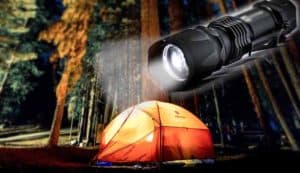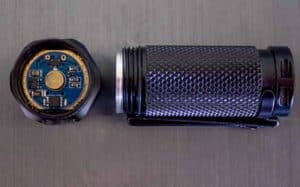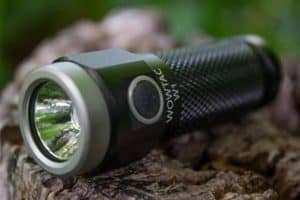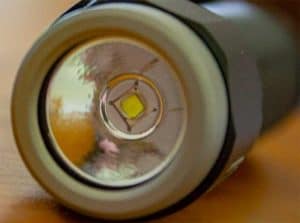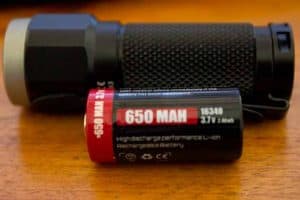This page may have Commerce Content. If you buy something from our posts, we may get a small share of the sale. Click here for more.
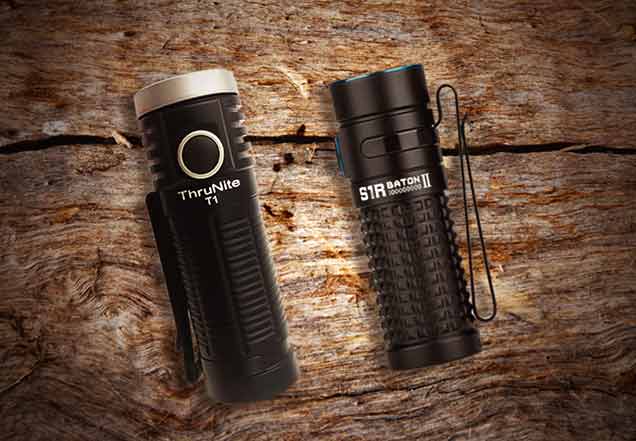

Editor & Article Writer for Outdoor Wilds
As an Amazon Associate I earn from qualifying purchases. Thank you for helping to support the site.
Thrunite T1 vs Olight S1R II
In this article I compare the Thrunite T1 [1] to the Olight [2] S1R II. On paper both have very similar characteristics. They are small baton style EDC flashlights ideal for most general applications.
A magnetic tail end is part of the features included for each.This is useful for any mechanical vehicle application, whereby attaching the flashlight to a vehicle body allows for easier inspection.
If you’re looking for an everyday carry flashlight then either one is a great choice.
It just comes down to personal preference in terms of how the user interface operates the output modes and the design features.
I’ll now go over all of the essential aspects of the flashlights to give you a clear picture of the differences between the T1 and S1R II.
Popular Posts
Accessories
Both flashlights come as a complete kit, ready to use straight out the box. The Thrunite pocket clip attaches to the body, whereas the Olight’s clips are fixed in place.
Both come with a lanyard and the Olight has a neat little carry pouch as an extra.
You get spare O-rings with the Thrunite and none with the Olight unfortunately, though they’re easy to get hold of.
The kit for both flashlights include a rechargeable battery and charging lead. The Thrunite uses a micro USB lead and the Olight has its own proprietary tail cap magnetic charge cable.
Overall, each flashlight comes with a fair complement of useful accessories.
Thrunite
- Pocket clip
- Spare O-rings x2
- Lanyard
- ThruNite 1100mAh 18350 battery
- USB Charging Cable
- Spare USB Rubber Cover
Olight
- Lanyard
- 550mAh 3.7V 10C IMR16340 battery
- Tail cap magnetic USB charging cable
- Battery box for storage
- Pouch
Flashlights Size Comparison
In terms of size, they’re very small, even for an EDC style flashlight. The Thrunite is the slightly bigger of the two. The extra length on the T1 is down to the battery being larger than the S1R.
You won’t notice any real difference in regards to weight between the two when carrying them in a pocket, again the T1 is slightly heavier.
If you’re someone who’s into ultra light hiking gear and weighs all their kit, then this could be a factor to consider.
- Thrunite – 2.5oz, 2.7 inches in length.
- Olight – 1.8oz, 2.48 inches in length.
Durability
As with all modern flashlights from the major brands, these 2 flashlights are about as tough as you’re going to get.
The Olight has been impact tested to 1.5 metres versus the Thrunite at only 1 metre.
IPX-8 rating at 2 metres allows you to use them in the water, as they are fully waterproof up to 2 metres depth.
So if you’re into any type of water activity such as kayaking, there shouldn’t be any issue with water ingress.
- Thrunite – IPX-8 to 2 metres – Drop test to 1 metre.
- Olight – IPX-8 to 2 metres – Drop test to 1.5 metres.
What's It Like To Carry Every Day?
The pocket clip on the T1 is adjustable, allowing it to rotate around the body. The T1 carries with the reflector down when inside a pocket.
Olights pocket clip is fixed directly behind the switch, this does make it easier to find the switch in the dark as it always remains in situ, unlike the T1’s clip which rotates.
The size and weight of these small flashlights are ideal to carry around all day without noticing they’re present.
Reflector and LED
I’ve put the LED type for each below for all those who are into the more technical aspects of flashlights.
In real world terms the smooth reflector on the Olight S1R II gives the beam more throw, whereas the orange peel reflector on the T1 makes for a more flood type beam.
Here’s a link to the Cree website if you’d like to know more about each of the LED emitters.
You’ll find PDF data sheets for both by doing a quick search on the site.
- Thrunite – Cree XHP 50 – Orange peel reflector.
- Olight – Cree XM-L2 CW – Smooth reflector.
Battery
There’s not a great deal separating the two flashlights so far, until we come to the batteries and things then start to get more interesting.
As mentioned earlier the thrunite has a larger battery which adds to the overall length of the T1’s body. With the additional size comes more capacity.
The Thrunite’s 18350 battery has a capacity of 1100mAh compared to the S1R battery’s 550mAh. This of course has an impact on the runtimes for each mode output as you’ll see in a moment.
Personally I prefer the 18350 battery and charge capability on the Thrunite with it’s micro USB charging port.
- Thrunite 3.7V 1100mAh 18350 battery.
- Olight 550mAh IMR RCR123A battery.
Charging
This really comes down to personal preference. Some people love the magnetic tail cap charging on the Olight.
It is a very neat way to charge your flashlight, there is no doubt.
The downside of course is that you have to carry an extra charging lead with you if you’re travelling and so on.
The Thrunite uses micro USB which is now pretty much standard for many electronic items these days.
It’s not a big deal I know, but for some, having to carry a charging lead specifically for a flashlight is just another lead to add to all the other charging leads when travelling.
Output Modes & Runtimes
The headline figure that almost everyone looks at when comparing flashlights is the lumen output.
The T1 outputs 1500 lumens and the S1R 1000 lumens. This does only tell half the story though.
If you take a look at the comparison table at the top of this article you’ll notice that the candela output for the Olight is 5250 cd and the Thrunite is rated at 2600 candela.
What this means in real world terms is that the Olight has the far greater maximum beam distance even though it has a lower lumen output.
The Thrunites maximum beam is 102 metres compared to the Olight at 145 metres. So there is quite a difference.
Whether you need that extra beam distance for an EDC light is debatable.
A longer beam distance can be useful for path finding at dusk when hiking on steep terrain for example.
The runtimes for both are listed below. It’s obvious that the Thrunite T1 is going to win here due to almost double the capacity of the battery.
The Olight does perform well though in regards to runtimes.
The lowest setting on the S1R II, moonlight will run for up to 8 days
Thrunite
- Turbo: 1500 lumens – 408 lumens (3mins+80mins)
- High: 685 lumens (80 minutes)
- Low: 15 lumens (36 hours )
- Firefly: 1 lumens (14 days)
- Strobe: 700 lumens (120minutes)
Olight
- Turbo 1000 lumens (37 minutes)
- High 600 lumens (45 minutes)
- Medium 60 lumens (3 hours 40 min)
- Low 12 lumens (20 hours)
- Moon 0.5 lumens (8 days)
User interface
Thrunite T1
The side switch on the T1 has a charge indicator. The indicator is red while charging and blue when fully charged.
During use, when the indicator turns red it’s time to charge the battery.
If you’ve used a Thrunite flashlight before then the UI (user interface) on the T1 will be familiar. Press the side switch to turn the light on/off.
A memory mode remembers the last output mode used, except turbo, firefly and stribe.
Turbo mode is a double click and strobe 3 clicks. You can also cycle through the standard modes by pressing and holding down the side switch.
Intensity is progressive as you hold down the switch, which is a nice feature.
Overall, the UI is well tried and tested on most of Thrunite’s other flashlights.
It’s really easy to learn for someone new to this type of user interface.
Olight S1R II
Three color charge indicators on the Olight tell you the percentage of power left.
Green indicates over 60%, Orange is between 10% – 60% and red denotes charge has dropped below 10%.
The UI is almost identical to the Thrunite (see above). The exception being when cycling through the modes on the Olight, it does include the lowest moonlight mode within the cycle, whereas the thrunite cycles from low to high progressively which some people prefer.
There is a timer function on the Olight. 9 minutes and 3 minutes, where the light will auto switch off at the selected time period.
A final word on the UI for both. They both work well in practice.
The Olight does shade it for me with the additional color charge indicators and it’s nice to have the lowest moonlight mode included in the cycle function.
The Thrunite progressive output while holding down the switch is worth considering as an option to have on your EDC flashlight.
Beam
If you’re looking for a longer throw beam for your EDC light then the Olight would be the preferred choice. The Thrunite has more of a flood type beam.
The color of the beam on the Thrunite is a little inconsistent. It fades from a yellow hot spot to a blueish spill.
I personally wouldn’t have an issue with the color output. If you’re using it as a critical close up form of illumination then this may be a consideration.
Both flashlights provide a lot of illumination from such a small body. They’re ideal for most general applications such as hiking, fishing, camping and so on.
Last update on 2024-03-29 / Affiliate links / Images from Amazon Product Advertising API
Last update on 2024-03-30 / Affiliate links / Images from Amazon Product Advertising API

